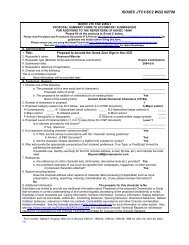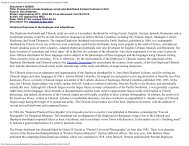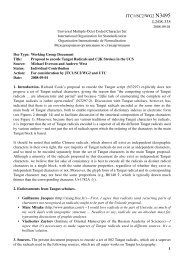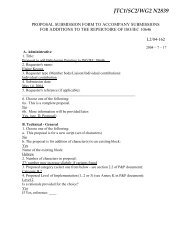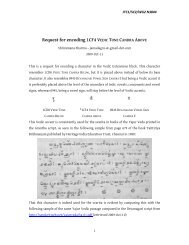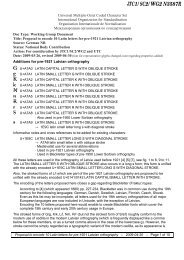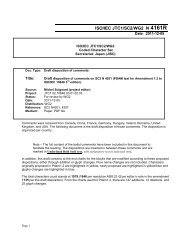Common Indic Number Forms - dkuug
Common Indic Number Forms - dkuug
Common Indic Number Forms - dkuug
You also want an ePaper? Increase the reach of your titles
YUMPU automatically turns print PDFs into web optimized ePapers that Google loves.
Proposal to Encode North <strong>Indic</strong> <strong>Number</strong> <strong>Forms</strong> in ISO/IEC 10646 Anshuman Pandey<br />
independent fraction signs, the quarter mark is a contextually and semantically distinct character in that it is<br />
written only with the signs that represent the fractions 1 ⁄4, 1 ⁄2, and 3 ⁄4.<br />
Variants The quarter mark may also be written as a closed dot, as is done with the independent fraction<br />
signs. The following example of Kaithi text shows the use of fraction signs to write rupayā and ānā values. 12<br />
The circled portion indicates the value17äæ “17 rupayā, 8 ānā.”<br />
5.3 Placeholder Mark<br />
û u+A837 north indic placeholder mark<br />
Description The placeholder mark is used to indicate the absence of a unit. It appears in written and<br />
printed texts, primarily in Maharashtra, where it is known as āl.ī (a) or al.ī (a), and in Gujarati 13 It<br />
was a common sign in the Modi script and appears in Peshwa records of the Maratha dynasty from at least<br />
the 16th century ce (see Figure 26). The placeholder mark appears in metal fonts such as Nirnaya-Sagar<br />
Pica No. 1 (Figure 27), Monotype Devanagari (Figure 28), and Vijapure Devanagari. 14<br />
Properties The placeholder mark belongs to the Unicode general category “Symbol, Other” (So). It has a<br />
bidirectional value of “Left-to-Right” (L).<br />
Orthography The placeholder mark is reserved for marking the absence of intermediate units, such as the<br />
pavalī unit of the Maharashtran currency system. For example, the notation2ûá represents the value “2<br />
rupayā and 2 ānā,” where the placeholder mark indicates “0 pavalī” (see Figure 18). If a quantity contains<br />
pavalī, but no rupayā, then the placeholder mark is written after a zero:0û2 “0 rupayā and 2 pavalī.”<br />
Variants The placeholder mark has historical variants in Maharashtra and Gujarat, which may reflect<br />
forms used in Modi (see Figure 19). The form that appears in Devanagari metal fonts is proposed here as<br />
the modern standard form.<br />
5.4 Currency Mark<br />
î u+A838 north indic rupee mark<br />
Description The north indic rupee mark was used for writing currency notations. The sign appears in<br />
both written and printed materials. The use of the quantity mark was not mandatory. When the sign was not<br />
used, the different currency units were still distinguishable by the method of writing the units. The semantics<br />
of the north <strong>Indic</strong> rupee mark are similar to the Bengali rupee mark, which is encoded in the Bengali block<br />
asu+09F2 bengali rupee mark.<br />
Properties The north indic rupee mark belongs to the Unicode general category “Symbol, Currency”<br />
(Sc). It is a non-combining sign. The mark has a bidirectional value of “European <strong>Number</strong> Terminator”<br />
(ET), similar to other currency marks encoded in the UCS.<br />
12 Grierson, 1899: Plate X.<br />
13 Molesworth, 1857: 58.<br />
14 Naik, 1971: 330.<br />
6



